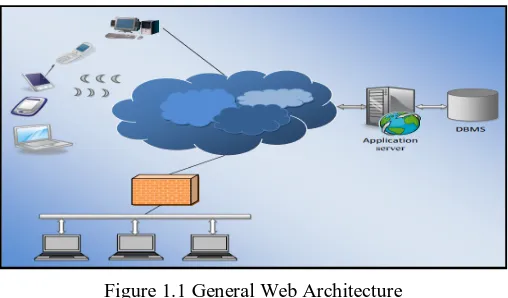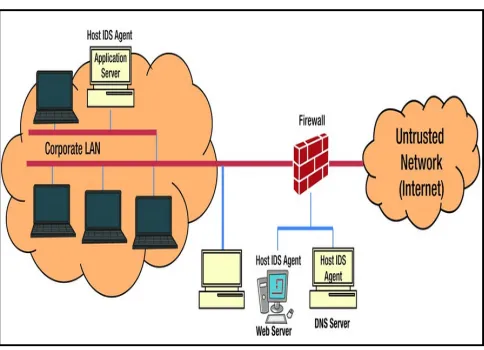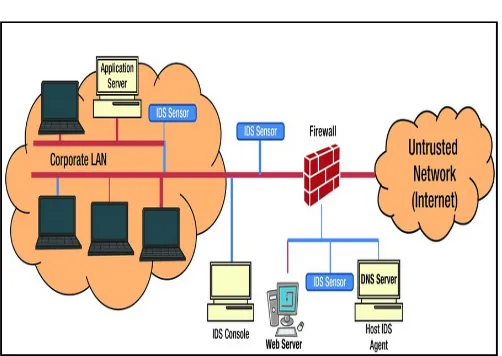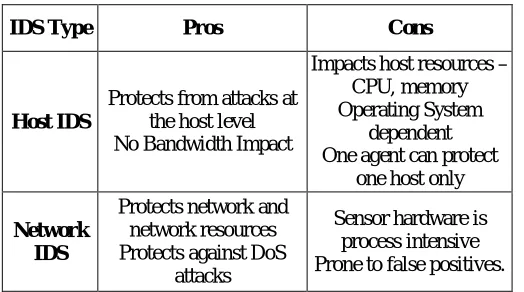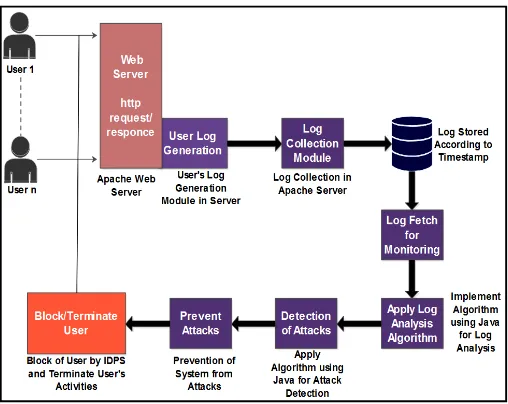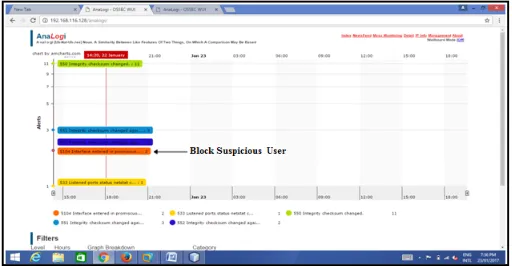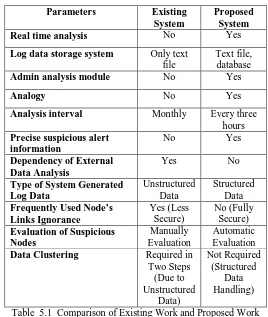ISSN(Online): 2320-9801
ISSN (Print) : 2320-9798
I
nternational
J
ournal of
I
nnovative
R
esearch in
C
omputer
and
C
ommunication
E
ngineering
(A High Impact Factor, Monthly, Peer Reviewed Journal)
Website: www.ijircce.com
Vol. 6, Issue 12, December 2018
Detection and Prevention of Attacks from
HTTP Server logs
Monika Soni, Saurabh Sharma
Research Scholar, Department of Computer Technology & Applications, Gyan Ganga College of Technology
Jabalpur (M.P.), India
Professor, Department of Computer Science & Engg, Gyan Ganga College of Technology
Jabalpur (M.P.), India
ABSTRACT: In Web site hacks are on the rise and pose a greater threat than the broad based network attacks as they threaten to steal critical customer, employee, and business partner information stored in applications and databases linked to the Web. We present an analysis of HTTP traffic in a large-scale environment which uses network flow monitoring extended by parsing HTTP requests the increasing shift towards web applications opens new attack vectors. Traditional protection mechanisms like firewalls were not designed to protect web applications and thus do not provide adequate defence. It is possible for a web site to be visited by a regular user as a normal (natural) visit, to be viewed by crawlers, bots, spiders, etc. for indexing purposes, lastly to be exploratory scanned by malicious users prior to an attack. An attack targeted web scan can be viewed as a phase of a potential attack and can lead to more attack detection as compared to traditional detection methods. In this work, we propose a method to detect attack-oriented scans and to distinguish them from other types of visits. In this context, we use access log files of Apache (or ISS) web servers and try to determine attack situations through examination of the past data and current web logs using timestamps. In addition to web scan detections, we insert a rule set to detect SQL Injection and XSS attacks. Our approach has been applied on sample data sets and results have been analyzed in terms of performance measures to compare our method and other commonly used detection and prevention techniques.
KEYWORDS: Apache Web Logs, HTTP, Timestamp, SQL Injection, XSS Attack, Server Logs
I. INTRODUCTION
Figure 1.1 General Web Architecture
Intrusion Detection Systems (IDS), though a new field of research, has attracted significant attention towards itself and presently almost every day more researchers are engaged in this field of work. The current trend for the IDS is to make it possible to detect novel network attacks. The major concern is to make sure that in case of an intrusion attempt, the system is able to detect and to report it. Intrusion detection systems (IDSs) are usually deployed along with other preventive security mechanisms, such as access control and authentication, as a second line of defence that protects information systems. There are several reasons that make intrusion detection a necessary part of the entire defence system. First, many traditional systems and applications were developed without security in mind. In other cases, systems and applications were developed to work in a different environment and may become vulnerable when deployed Intrusion detection complements these protective mechanisms to improve the system security. Moreover, even if the preventive security mechanisms can protect information systems successfully, it is still desirable to know what intrusions have happened or are happening, so that we can understand the security threats and risks and thus be better prepared for future attacks.
II. WEB INTRUSION DETECTION
Web application design, programming, and maintenance require a different skill set. Even if you have the skills, in a typical organization these tasks are usually assigned to someone other than a system administrator. But the problem of ensuring adequate security remains. This final chapter suggests ways to secure applications by treating them as black boxes and examining the way they interact with the environment. The techniques that do this are known under the name intrusion detection. Attacks detected by IDS/IPS:
ISSN(Online): 2320-9801
ISSN (Print) : 2320-9798
I
nternational
J
ournal of
I
nnovative
R
esearch in
C
omputer
and
C
ommunication
E
ngineering
(A High Impact Factor, Monthly, Peer Reviewed Journal)
Website: www.ijircce.com
Vol. 6, Issue 12, December 2018
Figure 1.2 Host-Based Intrusion Detection Systems
An HIDS can be as simple as a script watching a log file for error messages. Integrity validation programs (such as Tripwire) are a form of HIDS. Some systems can be complex: one form of HIDS uses system call monitoring on a kernel level to detect processes that behave suspiciously.
Because many NIDSs are in place, a large effort was made to make the most of them and to use them for web intrusion detection, too. Though NIDSs work well for the problems they were designed to address and they can provide some help with web intrusion detection, they do not and cannot live up to the full web intrusion detection potential for the following reasons:
NIDSs were designed to work with TCP/IP. The Web is based around the HTTP protocol, which is a
completely new vocabulary. It comes with its own set of problems and challenges, which are different from the ones of TCP/IP.
The real problem is that web applications are not simple users of the HTTP protocol. Instead, HTTP is only
used to carry the application-specific data. It is as though each application builds its own protocol on top of HTTP.
Many new protocols are deployed on top of HTTP (think of Web Services, XML-RPC, and SOAP), pushing
the level of complexity further up.
Figure 1.3 Network-Based Intrusion Detection and Prevention System
Vendors of NIDSs have responded to the challenges by adding extensions to better understand HTTP. The term deep-inspection firewalls refers to systems that make an additional effort to understand the network traffic on a higher level. Ultimately, a new breed of IDSs was born. Web application firewalls (WAFs), also known as web application gateways, are designed specifically to guard web applications. Designed from the ground up to support HTTP and to exploit its transactional nature, web application firewalls often work as reverse proxies. Instead of going directly to the web application, a request is rerouted to go to a WAF first and only allowed to proceed if deemed safe.
Web application firewalls were designed from the ground up to deal with web attacks and are better suited for that purpose. NIDSs are better suited for monitoring on the network level and cannot be replaced for that purpose.
Pros and Cons of HIDS and NIDS
Don’t leave sensitive data in plaintext
Encrypt private/confidential data being stored in the database.
This also provides another level of protection just in case an attacker successfully exfiltrates sensitive data.
Limit database permissions and privileges
Set the capabilities of the database user to the bare minimum required.
This will limit what an attacker can do if they manage to gain access.
ISSN(Online): 2320-9801
ISSN (Print) : 2320-9798
I
nternational
J
ournal of
I
nnovative
R
esearch in
C
omputer
and
C
ommunication
E
ngineering
(A High Impact Factor, Monthly, Peer Reviewed Journal)
Website: www.ijircce.com
Vol. 6, Issue 12, December 2018
IDS Type Pros Cons
Host IDS
Protects from attacks at the host level No Bandwidth Impact
Impacts host resources – CPU, memory Operating System
dependent One agent can protect
one host only
Network IDS
Protects network and network resources Protects against DoS
attacks
Sensor hardware is process intensive Prone to false positives.
Table 1.2 Pros and Cons of HIDS and NIDS
III. PREVENTION OF WEB ATTACKS
3.1 Prevent Cross-Site Scripting Attacks
The following suggestions can help safeguard your users against XSS attacks: i. Sanitize user input:
Validate to catch potentially malicious user-provided input.
3.2 Prevent SQL Injection Attacks
The following suggestions can help prevent an SQL injection attack from succeeding:
Don’t use dynamic SQL
This provides protection to web-facing applications.
It can help identify SQL injection attempts.
Based on the setup, it can also help prevent SQL injection attempts from reaching the application (and, therefore,
the database).
Avoid placing user-provided input directly into SQL statements.
Prefer prepared statements and parameterized queries, which are much safer.
Stored procedures are also usually safer than dynamic SQL.
Sanitize user-provided inputs
Properly escape those characters which should be escaped.
Verify that the type of data submitted matches the type expected.
Encode output to prevent potentially malicious user-provided data from triggering automatic load-and-execute
behaviour by a browser.
IV. PROPOSED ARCHITECTURE
Linux operating system. That complete virtualization is implemented on the windows operating system, which serves as the host operating system for Linux system. In the proposed system, server’s logs files are used to analyze the events perform in service provider system or server system. These log files are the activities or events of clients in the network. These log files are analyzed by using rule based analysis in the server in real time. When system finds some malicious activities during log analysis, it generates alerts messages to admin then admin take necessary actions to block the client’s system’s activities by using IDPS’s API.
The proposed framework is designed to show how the modules are integrated into the components and how they interact with each other to efficiently ensure the resilience of the enterprise network against intruders. Detailed below are the proposed design and the components
Figure 1.4 Proposed Architecture
V. WORKING STEPS OF PROPOSED METHODOLOGY
1. User request to Apache server for service. Grant server access for services.
2. Server start generate user’s logs file for record performed user events and activities. 3. Logs are collected in Log Collection Module in apache web server.
ISSN(Online): 2320-9801
ISSN (Print) : 2320-9798
I
nternational
J
ournal of
I
nnovative
R
esearch in
C
omputer
and
C
ommunication
E
ngineering
(A High Impact Factor, Monthly, Peer Reviewed Journal)
Website: www.ijircce.com
Vol. 6, Issue 12, December 2018
VI. RESULTS
Fig 1.5 Log information captured in real time
Fig 1.6 Graphical view of current activities in selected time duration
VII. COMPARISON OF EXISTING WORK AND PROPOSED WORK
Parameters Existing System
Proposed System
Real time analysis No Yes
Log data storage system Only text file
Text file, database
Admin analysis module No Yes
Analogy No Yes
Analysis interval Monthly Every three hours Precise suspicious alert
information
No Yes
Dependency of External Data Analysis
Yes No
Type of System Generated Log Data
Unstructured Data
Structured Data Frequently Used Node’s
Links Ignorance
Yes (Less Secure)
No (Fully Secure) Evaluation of Suspicious
Nodes
Manually Evaluation
Automatic Evaluation Data Clustering Required in
Two Steps (Due to Unstructured
Data)
Not Required (Structured
Data Handling)
Table 5.1 Comparison of Existing Work and Proposed Work
ISSN(Online): 2320-9801
ISSN (Print) : 2320-9798
I
nternational
J
ournal of
I
nnovative
R
esearch in
C
omputer
and
C
ommunication
E
ngineering
(A High Impact Factor, Monthly, Peer Reviewed Journal)
Website: www.ijircce.com
Vol. 6, Issue 12, December 2018
VIII. CONCLUSION
Various cyber threats have brought about numerous damages ranging from privacy information leakage to financial loss, to leakage of confidential corporate information. Of the cyber threats, APT attacks are particularly known for attacking continuously until they acquire long-time access authority or leak information by successfully intruding specific organizations or institutes. They many challenges for security, since they conduct an attack after sufficiently analyzing the vulnerabilities of a target system. Thus, the proposed system is able to minimize the possibility of initial intrusion and damages of the system by promptly responding through rapid detection of an attack when the target system is attacked. Advanced Persistent Attack is a serious problem in network security. Although there have been several solutions recently proposed to solve the problem, we have analyzed that no solution offers a feasible solution. So, we have proposed an efficient and secure mechanism for detection and prevention of APT attacks that is able to cope up with APT attacks.
Future work should be based on scalable, structured and computationally techniques which do not require prior knowledge, not dependable on security expert to frequently update rules and are able to detect known and unknown attacks.
REFERENCES
1. Louis Marinos, “ENISA Threat Landscape 2015 JANUARY”, European Union Agency For Network And Information Security, www.enisa.europa.eu, ENISA Threat Landscape 2015 | January 2016.
2. Danilo V. Bernardo, “Clear and present danger: Interceptive and retaliatory approaches to cyber threats”, Applied Computing and Informatics (2015) 11, 144–157, @ Elsevier.
3. Roger Meyer, Detecting Attacks on Web Applications from Log Files, SANS Institute InfoSec Reading Room, © SANS Institute 2008.
4. Muhammet Baykara, Resul Das, “A Novel Hybrid Approach for Detection of Web-Based Attacks in Intrusion Detection Systems”, International Journal of Computer Networks and Applications (IJCNA), Volume 4, Issue 2, March – April (2017).
5. Merve Bas Seyyar, Ferhat Özgür Çatak , Ensar Gül, “Detection of attack-targeted scans from the Apache HTTP Server access logs”, Applied Computing and Informatics 14 (2018) 28–36.
6. Mohammed A. Saleh and Azizah AbdulManaf, “A Novel Protective Framework for Defeating HTTP-Based Denial of Service and Distributed Denial of Service Attacks”, Hindawi Publishing Corporation Hindawi Publishing Corporation, Scientific World Journal Volume 2015.
7. Auxilia.M, Tamilselvan.D, “Anomaly Detection Using Negative Security Model in Web Application”, 978-1-4244-7818-7/10/$26.00_c 2010 IEEE.
8. Katerina Goseva-Popstojanova, Goce Anastasovski, and Risto Pantev,” Classification of malicious Web sessions”, 978-1-4673-1544-9/12/$31.00 ©2012 IEEE.
9. Martin Hus´ak, Petr Velan, Jan Vykopal, “Security Monitoring of HTTP Traffic Using Extended Flows”, Conference: 24-27 Aug. 2015, IEEE
Xplore: 19 October 2015.
10. Mansour Alsaleh, Abdulrahman Alarifi, Abdullah Alqahtani and AbdulMalik Al-Salman, “Visualizing web server attacks: patterns in PHPIDS
logs”, Security and Communication Networks
Security Comm. Networks 2015; 8:1991–2003 Published online 22 December 2014 in Wiley Online Library, Copyright © 2014 John Wiley & Sons, Ltd.
11. Niklas Särökaari, “How to identify malicious HTTP Requests”, Accepted: 13 November 2012, © 2012 The SANS Institute. 13. Jai Puneet Singh, “Analysis of SQL Injection Detection Techniques”, Theoretical and Applied Informatics, Vol 28, No 1&2 (2016).
14. Haibin Hu,” Research on the Technology of Detecting the SQL Injection Attack and Non-Intrusive Prevention in WEB System”, American Institute of Physics, 020205 (2017).
15. Vrushali S. Randhe, Archana B. Chougule, Debajyoti Mukhopadhyay, “Reverse Proxy Framework Using Sanitization Technique For Intrusion Prevention In Database”, CIIT 2013 International Conference, www.researchgate.net/publication, November 2013.
16. Harshad Gaikwad, Bhavesh B. Shah, Priyanka Chatte, “SQLi and XSS Attack Introduction and Prevention Technique”, International Journal of Computer Applications (0975 – 8887) Volume 165 – No.2, May 2017.
